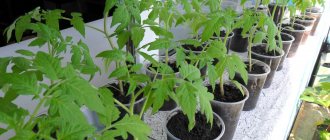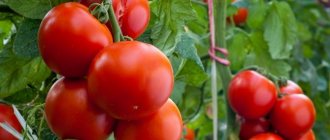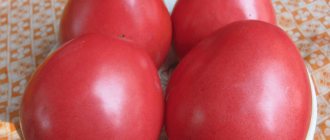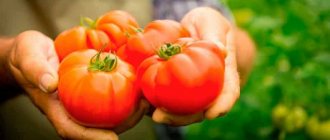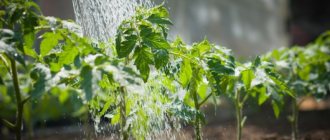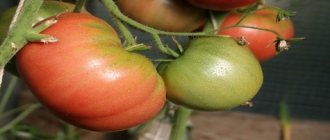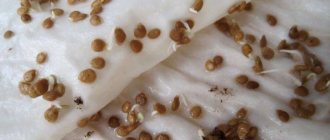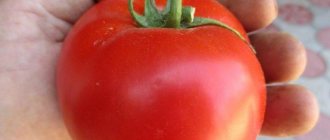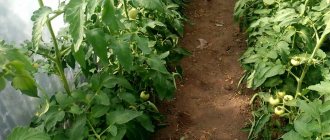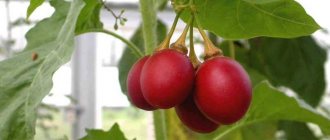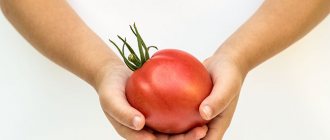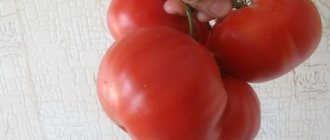Tomato Red Arrow F1: variety description
A fixed-point crop that does not require height control. The Red Arrow tomato bush must be formed from only 2-3 main shoots.
All side shoots (stepchildren) are removed. Such shoots break off throughout the entire growing season. The trunks are endowed with a fibrous and rigid structure and low stability. For this reason, the shoots need to be fixed to a support; they must be tied up.
The foliage is green, corrugated, elongated in shape with edges on the underside. The amount of foliage on the shoots is average.
Photo of tomato Red Arrow F1
During the flowering period, the bush is covered with bright yellow flowers capable of self-pollination. There are no barren flowers. In place of each flower an ovary is formed.
One average Red Arrow tomato bush can have up to 12 fruit clusters. Clusters are formed literally through 1 leaf blade. Up to 8-10 fruits ripen in a cluster. The density of the clusters and the weight of the fruit do not change.
On a note!
The Red Arrow variety is notable for its long fruiting period. Unripe fruits can ripen without losing their taste.
Tomato Red Arrow F1 - video
Features of outdoor care
After the seedlings are planted in a permanent place and take root, they need to be provided with constant care, which consists of timely watering, fertilizing, tying the bushes to supports, and treatment against pests.
It is necessary to water the plants regularly and ensure that the soil does not dry out, which can lead to crop loss. It is better to use root watering to avoid the occurrence of late blight. On hot days, experts advise irrigating the bushes in the evening, which will prevent them from burning out in the sun and ensure better absorption of moisture into the ground.
Feeding
Almost along with watering, it is necessary to fertilize the seedlings.
It is carried out in several stages, namely:
- The first feeding is done 10–14 days after planting in open ground using mineral fertilizers (50–60 g superphosphate, 30–50 g urea, 30–40 g ammonium sulfate, 20–25 g potassium salt per 10 liters of water) 0 .5 liters for each bush;
- the second feeding occurs after 3 weeks (80 g of double superphosphate, 3 g of urea, 50 g of potassium salt and 300 g of wood ash per 10 liters of water) in a hole made at a distance of 15 cm around the tomato;
- the next feeding is carried out during the ripening of the fruits with organic fertilizers (1 teaspoon of yeast, 1 teaspoon of sugar per 1 liter of warm water, later add another 5 liters of water).
Did you know? Previously, in France, to confess love, they gave a tomato, because there they called it the “apple of love.”
Since this tomato variety forms tall bushes and produces a large harvest, they must be formed and tied to a support. With the help of a garter, plant branches will not break, the fruits will ripen better and not spoil, and it will be easier to care for the tomatoes while weeding and loosening the soil.
To do this you need:
- near each bush, install a wooden stake or a metal or plastic pipe up to 1.5 m above ground level;
- loosely tie the trunk to the support with a rope or strips of fabric so as not to damage the plant;
- As the tomatoes grow, tie them up a few more times.
Soil care
Soil care involves constantly weeding the bed of weeds. After each watering or rain, loosen and hill up the soil, thereby providing the plant roots with oxygen and to prevent the occurrence of fungal diseases. Also, to retain moisture, it is advisable to mulch the ground around the stems with dry grass, straw, sawdust or compost.
The Red Arrow F1 tomato is a hybrid, so it is not susceptible to major diseases. Its main enemies include the Colorado potato beetle, spider mites, and aphids, which can be destroyed using insecticides such as Actellik (2 ml per 2 liters of water), Proteus (7 ml per 5 liters of water), Fufanon (10 ml per 10 liters of water), etc.
Important! It is necessary to apply insecticides strictly following the relevant instructions.
Characteristics of tomato fruits
Judging by the number of clusters and the degree of their fullness, we can conclude that the “Red Arrow” variety is high-yielding. All the fruits are the same size, which is very popular among gardeners and cooks.
The fruit is round in shape, with a concave base and a pressed top. The weight of one Red Arrow tomato can reach 130 grams.
The color of the thin but elastic peel is raspberry-red. The color of the tomato is uniform, only as it ripens, a yellow spot is observed on the stalk, which subsequently disappears. The entire surface has no edges and is smooth.
The red flesh is dense, juicy with a small amount of small grains and white fibers.
Tomato Red Arrow F1 is a hybrid,
Therefore, you should not try to grow it from seeds yourself. Otherwise, the vegetable will not be able to take on varietal characteristics from its parents.
The originators of the Red Arrow tomato variety claim that the crop is endowed with frost resistance. In addition, it is adapted for risky farming.
Fruiting culture
Breeders have worked hard on the yield of the Red Arrow tomato variety. A significant number of fruits will ripen on the bushes for a long time and regularly. High yields are ensured for the Red Arrow tomato both in greenhouses and in open ground conditions. In addition, “Red Arrow” bushes can withstand short periods of drought and slight and short-term drops in temperature.
The crop has no special requirements for enhanced lighting when grown in greenhouse conditions
. This variety can grow under indeterminate crops. In open ground, the Red Arrow tomato can be grown in partial shade. Such conditions are more suitable for the variety than open areas, where tomatoes will need to be protected from the scorching rays of the sun and moistened more often.
If agricultural technology is not followed, the fruits will not reach the standard size. One bush of the Red Arrow variety promises a harvest of 4 kg.
Advice!
The recommended number of bushes per 1 m2 is 6 pieces. In this case, from 1 m2 you can get up to 24 kg of fruit per season.
All tomatoes of this variety are universally used. They can be eaten fresh, heat-treated, frozen, fermented, and salted. Often they are used to prepare sauces, juice, and paste.
Tomato Peter the Great
Mid-early (105-110 days period from germination to the beginning of ripening), indeterminate tomato hybrid. In the middle zone, it is recommended to grow it in a greenhouse.
The bush is tall and requires tying to a support and pinching. The best results were obtained when forming 2 and 3 stems. 5-6 fruits are formed in the brush.
The leaves of this tomato are long and dark green in color. The inflorescence is simple.
Basic qualities of fruits
The fruits are cylindrical with a “spout”, dense, with a durable skin, red in color at maturity, weighing 90-120 grams, 10-12 cm long, excellent (for a hybrid) taste. Recommended for fresh use, canning and pickling.
The value of the hybrid: resistance to Verticillium wilt, high quality fruits, transportability and ability to be stored for a long time.
Productivity: up to 9 kg of fruits per 1 sq.m of planting (with proper agricultural technology).
Seed producer: Sedek agricultural company.
Tomato Peter the Great F1 was included in the State Register of the Russian Federation in 2015 for cultivation in film greenhouses and under film covers in private household plots.
Features of cultivation
Sowing seeds for seedlings is carried out 60-65 days before the intended planting in the ground. Seedlings dive at the stage of appearance of the second true leaf. When planting seedlings in a permanent place per 1 sq. No more than 3 plants are placed per meter of plot; when formed into 1 stem - up to 4.
If you grew Peter the Great tomatoes, please write whether you liked them or not. What was the yield and taste of the fruits like under your climatic conditions? If possible, attach a photo of the entire bush or individual fruits you grew.
Your reviews of the Peter the Great tomato and additions to the description will help many gardeners evaluate this hybrid objectively and decide whether it is worth planting or not.
Pests and diseases
Breeders have endowed the genetic basis of the Red Arrow variety with immunity from a significant number of diseases. This culture can resist fusarium, late blight, and cladosporizosis.
With high humidity, nitrogen deficiency in the soil and high temperature, the plant can be affected by microsporosis. In this case, tissue damage (necrosis) will appear on the foliage and shoots. When grown in open ground conditions, such a problem with the crop will not arise. The gardener will be pleased to know that this variety will not be attacked by insect pests.
Positive and negative sides
At the beginning of work on this variety, scientists tried to take into account all the negative aspects of growing tomatoes. As a result, they received a culture without serious shortcomings.
There is only one minor disadvantage of growing the “Red Arrow” variety - the need to remove the stepsons and tie the tomatoes to a support. Another nuance is the short shelf life of the crop, which during transportation can retain its presentation for usually no more than 4 days.
The plant has more positive aspects
:
- regular and abundant harvest;
- possibility of growing in partial shade and in open ground;
- early ripening of the Red Arrow tomato;
- long fruiting period;
- average fruit size, which is important for preservation;
- high taste of Red Arrow tomato;
- versatility of crop application;
- cold resistance, frost resistance;
- immunity from insect pests.
A variety of pink tomatoes!
Description of the variety Pink Bush
Advantages and disadvantages
Pros:
- early ripeness;
- good taste;
- universal purpose of fruits;
- high commercial quality and excellent appearance;
- low light resistance;
- cold resistance;
- immunity to major diseases;
- high yield.
Minuses:
- It is impossible to obtain good seeds from hybrid fruits.
- The positive qualities of this variety include:
- unpretentious to growing conditions;
- withstands temperature changes;
- high yield (4 kg from 1 bush);
- good presentation, fruits do not burst;
- universal use;
- It lasts for a long time and tolerates transportation well;
- resistant to major diseases;
- not demanding of care, no need for stepsons.
The disadvantage is the need to tie the bushes to a support.
Tomato Red Arrow: planting and further care
For each variety of tomato there are some growing features.
Growing Red Arrow tomato seedlings
Soil consisting of turf soil, sand and peat is poured into the planting containers. The soil is moistened and depressions are made into which Red Arrow tomato seeds are placed. It is recommended to maintain a spacing of 1.5 cm between plantings.
Next, the planted seeds are sprinkled with soil mixed with organic matter. To create a favorable microclimate, a transparent film or glass is placed on the surface of the container.
The containers are placed in places with good lighting and positive temperatures, about +20...+22C.
Growing tomato seedlings - video
As soon as young shoots appear, the glass is removed and the tomato seedlings are fertilized with complex compounds. The planting should be moistened after the soil has dried.
From the moment the third leaf appears on the sprouts, the plants are planted in separate pots. In order for future seedlings to be less stressed, it is recommended to use peat pots, which are subsequently planted in the ground along with the container.
Transplanting tomato seedlings into a greenhouse and open ground
If Red Arrow tomatoes are planned to be grown in open ground, sowing must be done 60 days before the planned date. Weather conditions should exclude the possibility of return frosts. For most regions of Russia, this is the end of May-beginning of June.
Important!
If the Red Arrow tomato seedlings dive into a heated greenhouse, then this can be done in mid-April. Seedlings are planted in an unheated greenhouse in mid-May.
In open ground, tomatoes are planted at the rate of 6 pieces per 1 m2.
Seedlings can be planted in individual planting holes or rows. The main thing is that it is convenient for the gardener to subsequently organize the care of the vegetable crop.
A variety of green tomatoes!
Tomato "Swamp"
Growing seedlings
Growing seedlings from seeds is a fairly simple task. Purchased seed is convenient: it has already been processed by the manufacturer and does not need to be disinfected.
Place the seeds on a plate and cover with a little water. At this point, prepare the soil and container for seedlings. Ideal if it is elongated and wide. Seedlings love space.
It’s great if you buy the soil in a special store and it is intended for vegetables. Its composition should include peat, sand, and a little humus.
If you use soil from your own site, it should be disinfected.
Before this, the soil must be placed on a baking sheet and placed in the oven at a temperature of 60 °. The soil should remain there for about an hour, after which let it cool. After this you can start sowing.
- Place the soil in the container.
- Water it well.
- Make small depressions in the ground about 3 cm apart.
- Drop a few Red Arrow seeds into the holes.
- Level the ground.
- Water well again.
You can plant seedlings in greenhouses as early as April
There is no need to place the seed under the film. He will be accepted just fine. Place the pot on the windowsill on the sunny side of the house and wait for the first shoots to appear.
():
Cover the seedling containers with glass or transparent film to maintain constant moisture in the soil until the seeds germinate. If this is not done, a small layer of soil in the box may dry out quickly.
Recommendations for agricultural technology
Seeds of this variety should be purchased only at retail outlets. It makes no sense to collect seed from fruits grown in your garden.
It is necessary to grow this crop only by seedling method.
It is useful to know that the purchased seed does not need to be subjected to pre-planting treatment, since the seeds have already been prepared before sale.
On a note!
Agricultural technology for the Red Arrow tomato is not particularly demanding or complex.
It is enough to tie the plant in time so that its branches do not break off under the influence of the wind and the weight of the fruit. Tomatoes should be moistened and hilled regularly. To make caring for the Red Arrow tomato easier, you can mulch the area around the trunk.
Vegetable crops should be fertilized once every 30 days.
Tomato Red Arrow F1: reviews from those who planted and grew the hybrid
Many gardeners have already tried to grow the Red Arrow tomato variety in their gardens - reviews are presented below.
Teplishin Stanislav Nikolaevich, Razumnoe village: I have been growing “Red Arrow” for three years now. I like this variety for its resistance to cold and good yield. The main thing is to tie up its branches in time so that they do not break off and take stepson.
Galdobina Lyubov Sergeevnaya, Abakan: I regularly purchase new varieties of tomatoes. Last year I had experience growing Red Arrow. The variety turned out to be productive and economical in terms of planting space. Suitable for planting among indeterminate varieties. I grow Red Arrow in a heated greenhouse.
Petrushin Nikolay Petrovich, Serov: Having a small summer cottage, which I visit on weekends, I selected crops that were undemanding in care. I tried to grow Red Arrow tomatoes and did not regret it. I got a good harvest from a small number of bushes. It was enough for preparations for the winter and for use throughout the summer season. The wife was pleased with the identical size of the fruits and their taste.
